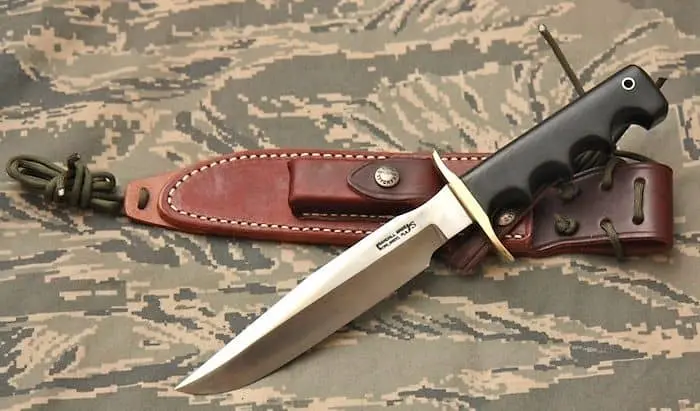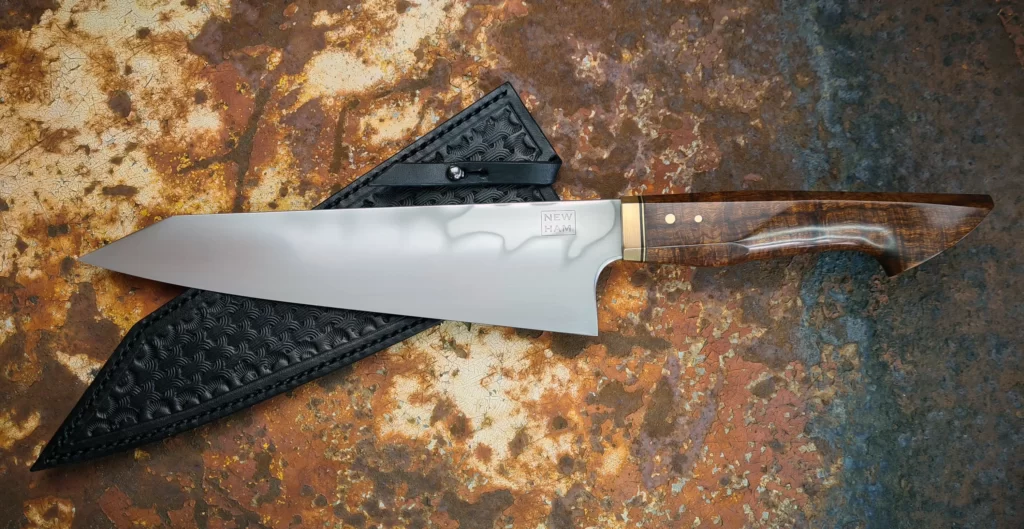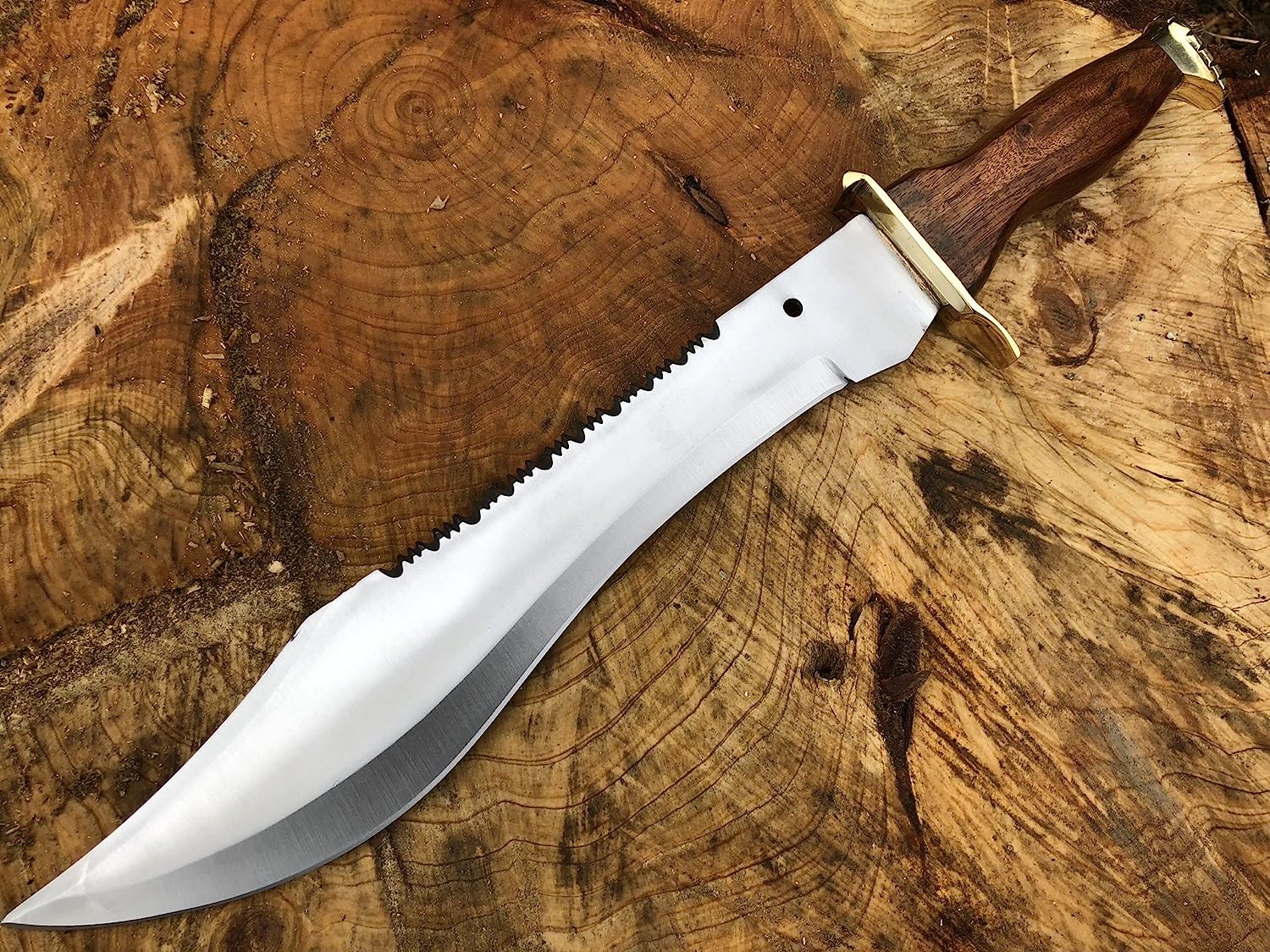Hunting knives are essential for outdoor activities. Understanding hunting knives and their uses is essential for hunters, outdoor enthusiasts, campers, and survivalists. This article covers hunting knives, their types, uses, maintenance, and more. Grab your gear and let’s hunt knives!
What is a Hunting Knife?
Hunting knives are versatile cutting tools designed for outdoor activities. Its sharp blade and strong handle provide it excellent control and leverage. Outdoor enthusiasts can choose from a variety of hunting knives in different sizes, blade styles, and handle materials.
These knives are built to withstand tough jobs including gutting and processing wildlife, preparing meat, building shelters, and campground duties. Hunting, fishing, and camping are all enhanced with a hunting knife.
The History and Evolution of Hunting Knives
Early humans relied on sharp-edged tools to survive. Flint, obsidian, and other stones made the first hunting blades. Hunting blades were made from copper, bronze, and iron as civilizations advanced. Hunting blades improved greatly with steel.
Different Types of Hunting Knives

Each hunting knife has a distinct purpose. Let’s examine some popular hunting knives:
Fixed-blade Knives
Fixed-blade knives are tough. The handle extends a solid, non-folding blade. Field dressing game, chopping wood and other outdoor duties are easy with these sturdy knives. Hunters and survivalists like fixed-blade knives because they shatter less easily.
Folding Knives
Pocket knives, or folding knives, are portable. The blade folds into the handle, making them portable. Folding knives can cut ropes, cook food, and defend yourself in emergencies. Folding the blade into the handle makes them safer to carry in your pocket or bag.
Skinning Knives
Game animal skinning knives are designed to work quickly. Their tiny, curved blades allow precise peeling. The curving design protects the hide and meat underneath. Hunters need skinning knives to field dress wildlife faster.
Guthook Knives
Field dressing game animals requires gut hook knives. The blade spine has a curled hook at the tip. The hook opens the animal’s abdomen without puncturing its organs. Gut hook knives make incisions safely and easily. They help hunters prevent unintentional cuts that ruin meat.
Multitool Knives
Multi-tool knives are compact and versatile. These knives have screwdrivers, bottle openers, saws, and pliers. Outdoor enthusiasts like multi-tool knives for their versatility. They help with hunting, camping, and survival duties.
After discussing hunting knife varieties, let’s learn how to choose the proper one.
Choosing the Right Hunting Knife

Given the many alternatives, choosing a hunting knife can be difficult. However, a few essential characteristics can simplify decision-making. Consider these hunting knife factors:
Blade Material
Blade material determines knife longevity, sharpness, and corrosion resistance. Stainless, carbon, and high-carbon stainless steel blades are common. Sharpening stainless steel blades can be difficult. Carbon steel blades are sharp but corrode easily. High-carbon stainless steel is sharp and corrosion-resistant.
Blade Design
Blade design affects its versatility. Drop, clip, and tanto blades are common. Drop point blades may peel and cut. Clip point blades are perfect for precision operations like piercing and detailing. Tanto blades are heavy-duty and have a robust tip.
Handle Material
Handle material impacts knife grip, comfort, and durability. Handle materials vary. Wood, rubber, plastic, and synthetic composites make handles. Wood handles are classic but require additional upkeep.
Rubber and plastic handles grip well and resist moisture, making them perfect for damp and slippery environments. G-10 and Micarta are durable, grippable, and temperature-resistant synthetic composites.
Tang Type
Blade tangs extend into handles. The tang strengthens the knife. Full, partial, and hidden tangs exist. Full tangs provide optimal strength and longevity. Partial tangs extend partially into the handle, while hidden tangs are totally hidden. For heavy-duty jobs, full-tang knives are the most durable.
Knife Size
Personal preference and use should determine hunting knife size. Chopping and batoning wood require powerful, long-bladed knives. Detail work and precise tasks are easier with smaller knives with shorter blades. Your hunting knife size should combine mobility and functionality.
These characteristics might help you choose a hunting knife that meets your demands. Choose a knife that fits your hand and matches your outdoor needs.
Popular Brands and Models of Hunting Knives

Several hunting knife manufacturers are renowned for their quality and dependability. Consider these popular brands and models:
Buck Knives
Buck Knives is famous for making high-quality hunting knives. They make durable, sharp, ergonomic knives. Hunters love the Buck 110 Folding Hunter and Buck 119 Special.
Benchmade
Benchmade makes high-quality hunting knives. Innovative designs, superior materials, and great blade performance are their trademarks. Benchmade Griptilian and Hidden Canyon Hunter are popular models.
Gerber
Hunters, military, and outdoor enthusiasts have relied on Gerber knives for 80 years. They make affordable, reliable hunting knives. The Gerber StrongArm and Gerber Moment Field Dress Kit are hunting favourites.
Spyderco
Spyderco hunting knives are noted for their inventive designs. They prioritise ergonomics, functionality, and usability. Outdoor aficionados like the Paramilitary 2 and Tenacious.
Cold Steel
Cold Steel is robust and durable. They make tough hunting knives. The Cold Steel Master Hunter and SRK (Survival Rescue Knife) are popular for their power and adaptability.
There are several additional well-known brands and models. Research and read reviews to pick the finest hunting knife for you.
How to Maintain and Care for Your Hunting Knife

Hunting knives must be maintained to last and perform well. Tips for maintaining your hunting knife:
Clean and Dry
Cleaning your hunting knife after use removes dirt, debris, blood, and moisture. Use a gentle brush to clean tough debris off the blade with warm water and a light soap or detergent. Avoid damaging the blade or handle with strong chemicals or abrasives. To avoid rust, dry the knife after cleaning.
Blade Sharpening
Sharpening the blade improves cutting. Sharpening keeps your hunting knife effective. Whetstones, sharpening rods, and guided systems sharpen. Follow the manufacturer’s directions for the best results.
Lubrication
Lubricating your hunting knife periodically prevents rust and improves performance. Lubricate the blade, pivot points, and other moving parts. This prevents rust and preserves the knife. Avoid over-application and use a knife-specific lubricant.
Storage
Maintaining your hunting knife requires proper storage. Keep your knife dry. Use a sheath or blade cover to prevent accidents and injury. To safeguard the blade when storing, lightly oil it.
Follow these maintenance steps to keep your hunting knife in top shape and ready to use.
Safety Tips for Using a Hunting Knife

Hunting knives can be lethal if handled improperly. Hunting knife safety:
Correct Gripping
Hold the knife firmly and away from the blade’s cutting edge. Avoid cutting yourself by placing fingers or thumbs in front of the blade. To avoid accidents, use good hand posture and grasping.
Knife Care
Check your hunting knife for wear, damage, and loose parts. Examine the blade’s sharpness, handle, and condition. Fix or replace the knife if you find problems. Maintaining your knife prevents tool-related mishaps.
Always prioritise safety when utilising hunting or outdoor gear, especially knives. Following these safety instructions lets you enjoy hunting knives without the risks.
Hunting Knife Accessories and Extras

The hunting knife and its attachments can improve your outdoor experience. Popular choices:
Knife Sheaths
Knife sheaths protect the blade and allow simple access. Leather, nylon, and Kydex sheaths are offered. Belt, neck, and MOLLE-compatible sheaths exist. The correct sheath protects and transports your hunting knife.
Honing Tools
Hunting knives may be sharpened in the field with the right gear. Pocket sharpeners and sharpening stones are compact and lightweight for outdoor use. These tools let you easily sharpen the blade for optimal cutting performance.
Knife Care Kits
Hunting knives require cleaning, lubrication, and upkeep. These packages comprise knife-care cleaning solutions, lubricants, brushes, and cloths. A complete maintenance package can help you maintain your hunting knife for years.
Survival Gear
If you’re a camper or hiker, extra survival gear can help. Fire starters, compasses, signal whistles, and emergency blankets may enhance your hunting knives and outdoor preparedness.
Customization Choices
Many hunters customise their knives to suit their tastes. Engraved handles, blade etchings, and paracord wraps or lanyards can be added. Customising your hunting knife lets you express yourself.
These attachments and extras can enhance your hunting knife experience and provide convenience and customization.
Questions (FAQs)
Hunting knife?
Outdoorsmen use hunting knives. Field dressing, skinning and general cutting require a sharp blade.
What hunting knives exist?
Fixed blade, folding, skinning, gut hook, and multi-tool hunting knives exist. Each variety is useful for different hunting and outdoor tasks.
What hunting knife is best?
Hunting knives vary in blade material, design, handle material, tang type, and size. Choose a knife that fits your needs, tastes, and comfort.
Maintaining a hunting knife?
Hunting knives should be cleaned after each use, dried, sharpened, lubricated, and stored in a dry place. Knife maintenance prolongs and optimises performance.
Which hunting knives are popular?
Buck, Benchmade, Gerber, Spyderco, and Cold Steel make popular hunting knives. These brands are noted for their craftsmanship and dependability.
Hunting knives—dangerous?
Handle hunting knives carefully. To avoid mishaps, practise good gripping, follow knife safety regulations, and check the knife for wear and damage.
Conclusion
Hunting and outdoors exploration require a flexible hunting knife. Understanding the numerous types of hunting knives, picking the best one for your needs, and practising proper maintenance and safety may provide you a reliable and efficient instrument for outdoor activities.
